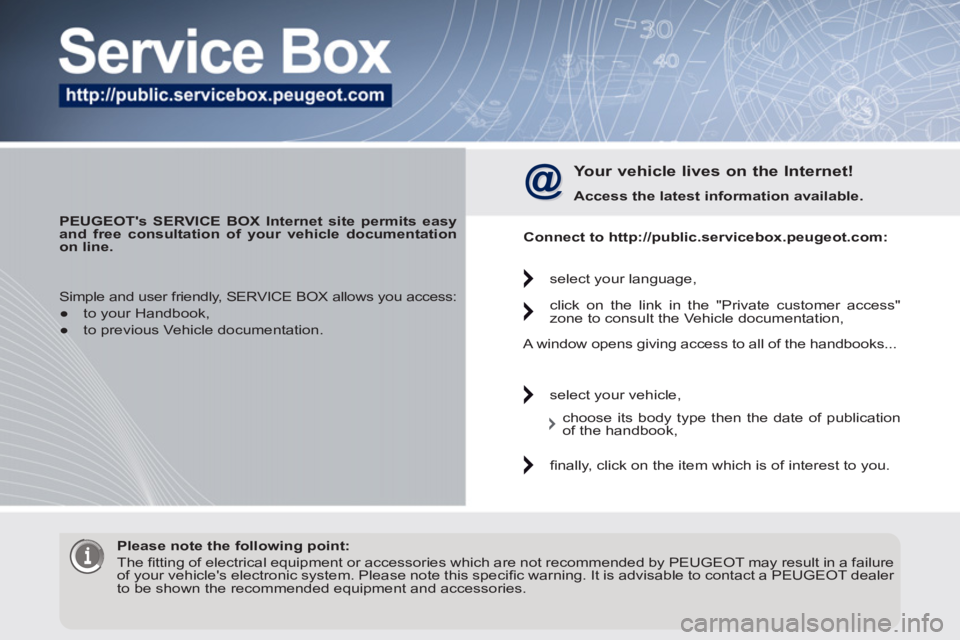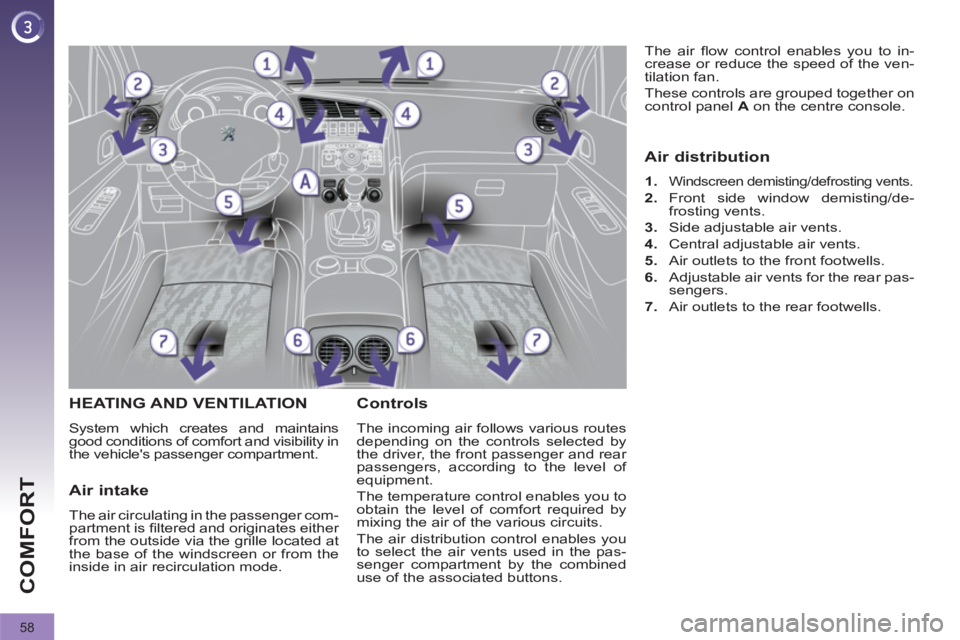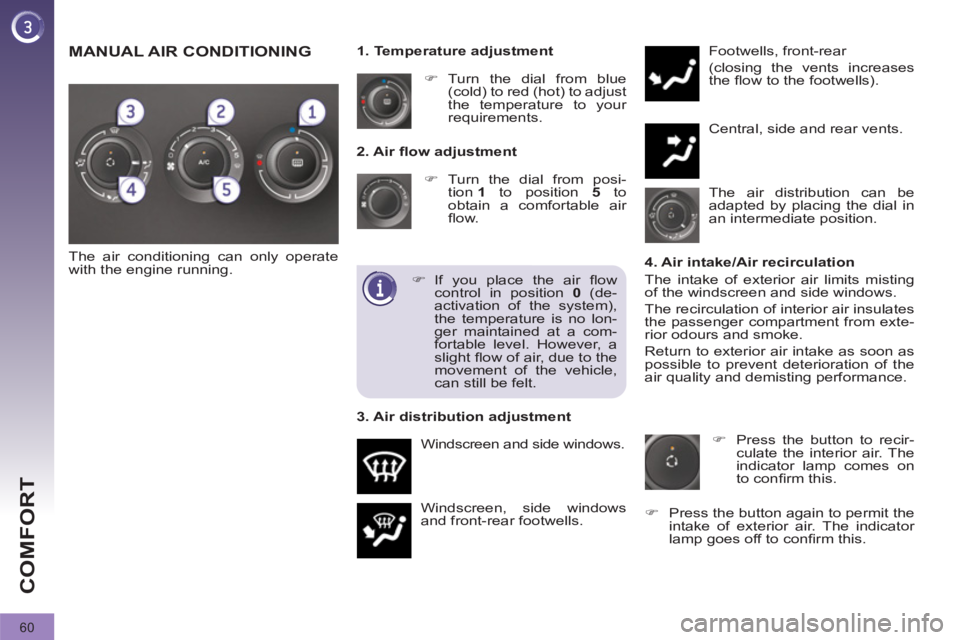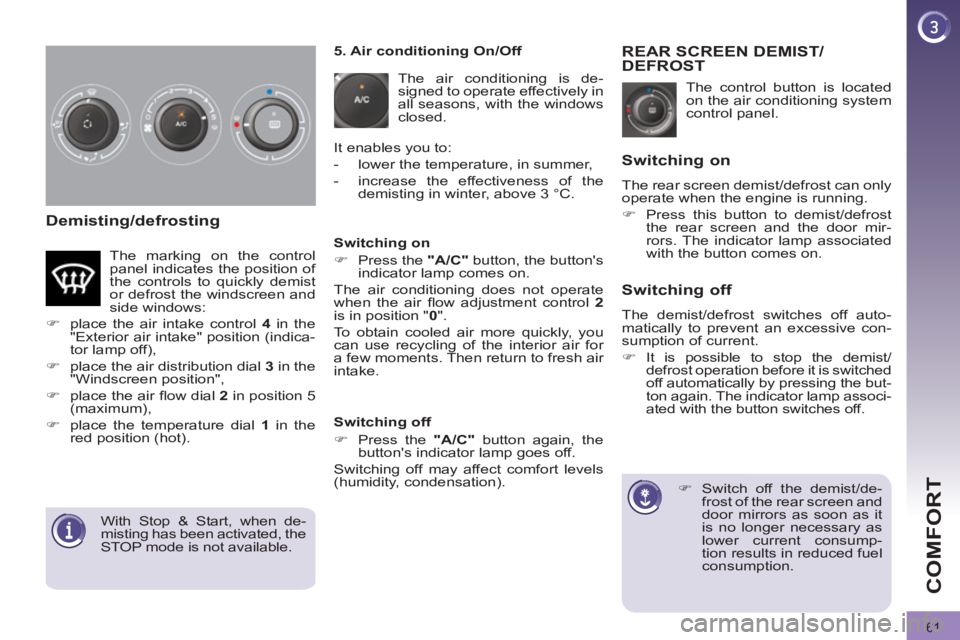2012 PEUGEOT 3008 window
[x] Cancel search: windowPage 2 of 328

PEUGEOT's SERVICE BOX Internet site permits easy
and free consultation of your vehicle documentation
on line.
Your vehicle lives on the Internet!
Access the latest information available.
Connect to http://public.servicebox.peugeot.com:
Simple and user friendly, SERVICE BOX allows you access:
●
to your Handbook,
●
to previous Vehicle documentation.
Please note the following point:
The fi tting of electrical equipment or accessories which are not recommended by PEUGEOT may result in a failure
of your vehicle's electronic system. Please note this specifi c warning. It is advisable to contact a PEUGEOT dealer
to be shown the recommended equipment and accessories. select your language,
click on the link in the "Private customer access"
zone to consult the Vehicle documentation,
select your vehicle,
fi nally, click on the item which is of interest to you. choose its body type then the date of publication
of the handbook, A window opens giving access to all of the handbooks...
Page 4 of 328

CONTENTS
FAMILIARISATION 4-26
INSTRUMENTS and
CONTROLS 27-41CHILD
SAFETY 113-123
MULTIFUNCTION
SCREENS 42-57SAFETY 124-136 COMFORT 58-73
ACCESS 74-88
VISIBILITY 89-99FITTINGS 100-112
Instrument panels 27
Indicator and warning lamps 29
Indicators 37
Adjustment buttons 41Child seats 113
ISOFIX child seats 120
Child lock 123
Screen A without audio
equipment 42
Screen A with audio equipment 44
Screen C
(Peugeot Connect Sound) 46
16/9 retractable colour screen
(Peugeot Connect Navigation
(RNEG)) 49
16/9 high definition retractable
colour screen
(Peugeot Connect Media) 51
Trip computer 54Direction indicators 124
Hazard warning lamps 124
Horn 124
Tyre under-inflation detection 125
ESC system 126
Grip control 128
Front seat belts 130
Airbags 133 Heating and Ventilation 58
Manual air conditioning 60
Rear screen demist/defrost 61
Dual-zone digital air
conditioning 62
Front seats 65
Rear seats 69
Mirrors 71
Steering wheel adjustment 73
Remote control key 74
Alarm 79
Electric windows 81
Doors 83
Boot 85
Lower tailgate 86
Fuel tank 87
Misfuel prevention 88
Lighting controls 89
Automatic illumination of
headlamps 92
Headlamp adjustment 92
Directional lighting 93
Wiper controls 94
Automatic rain sensitive wipers 96
Courtesy lamps 97
Interior mood lighting 98Interior fittings 100
Front armrest 102
Rear multimedia 104
Panoramic sunroof 106
Boot fittings 107
ECO-DRIVING 25
Page 11 of 328

9
FAMILIARISATION
INSTRUMENTS AND CONTROLS
1.
Cruise control/speed limiter
switches.
2.
Steering wheel adjustment control.
3.
Lighting and direction indicator
control stalk.
4.
Instrument panel.
5.
Driver's airbag.
Horn.
6.
Gear lever.
7.
Electric parking brake.
8.
Front armrest - Peugeot Connect
USB and/or auxiliary socket.
9.
Bonnet release.
10.
Driver's storage compartment
(Handbook).
11 .
Alarm button.
Parking sensors button.
Dynamic stability control button
(ESP/ASR).
Stop & Start deactivation button.
12.
Manual headlamp adjustment.
Instrument panel navigator
associated with the Peugeot
Connect Media Navigation
(NG4 3D).
13.
Door mirror controls.
Electric window controls.
Child lock.
14.
Front side window demisting vent.
15.
Windscreen demisting vent.
Page 27 of 328

Optimise the use of your
gearbox
With a manual gearbox, move off gen-
tly, change up without waiting and
drive by changing up quite soon. If
your vehicle has the system, the gear
shift indicator invites you to change up;
it is displayed in the instrument panel,
follow its instructions.
With an automatic or electronic gear-
box, stay in Drive "D"
or Auto "A"
, ac-
cording to the type of gearbox, without
pressing the accelerator pedal heavily
or suddenly.
Drive smoothly
Maintain a safe distance between ve-
hicles, use engine braking rather than
the brake pedal, and press the accel-
erator progressively. These practices
contribute towards a reduction in fuel
consumption and CO
2 emissions and
also helps reduce the background traf-
fi c noise.
If your vehicle has cruise control, make
use of the system at speeds above
25 mph (40 km/h) when the traffi c is
fl owing well.
Control the use of your electrical equipment
Before moving off, if the passenger
compartment is too warm, ventilate it by
opening the windows and air vents be-
fore using the air conditioning.
Above 30 mph (50 km/h), close the win-
dows and leave the air vents open.
Remember to make use of equipment
that can help keep the temperature in
the passenger compartment down (sun
roof and window blinds...).
Switch off the air conditioning, unless
it has automatic digital regulation, as
soon as the desired temperature is at-
tained.
Switch off the demisting and defrosting
controls, if not automatic.
Switch off the heated seat as soon as
possible.
Switch off the headlamps and front
foglamps when the level of light does
not require their use.
Avoid running the engine before moving
off, particularly in winter; your vehicle will
warm up much faster while driving.
As a passenger, if you avoid connecting
your multimedia devices (fi lm, music,
video game...), you will contribute to-
wards limiting the consumption of elec-
trical energy, and so of fuel.
Disconnect your portable devices be-
fore leaving the vehicle.
ECO-DRIVING
25
Eco-driving is a range of everyday practices that allow the motorist to optimise their fuel consumption and CO2 emis-
sions.
Page 60 of 328

58
COMFORT
HEATING AND VENTILATION
System which creates and maintains
good conditions of comfort and visibi lity in
the vehicle's passenger compartment.
Controls
The incoming air follows various routes
depending on the controls selected by
the driver, the front passenger and rear
passengers, according to the level of
equipment.
The temperature control enables you to
obtain the level of comfort required by
mixing the air of the various circuits.
The air distribution control enables you
to select the air vents used in the pas-
senger compartment by the combined
use of the associated buttons. The air fl ow control enables you to in-
crease or reduce the speed of the ven-
tilation fan.
These controls are grouped together on
control panel A
on the centre console.
Air intake
The air circulating in the passenger com-
partment is fi ltered and originates either
from the outside via the grille located at
the base of the windscreen or from the
inside in air recirculation mode.
Air distribution
1.
Windscreen demisting/defrosting vents.
2.
Front side window demisting/de-
frosting vents.
3.
Side adjustable air vents.
4.
Central adjustable air vents.
5.
Air outlets to the front footwells.
6.
Adjustable air vents for the rear pas-
sengers.
7.
Air outlets to the rear footwells.
Page 61 of 328

59
COMFORT
Recommendations for ventilation and air conditioning
In order for these systems to be fully effective, follow the operation and mainte-
nance guidelines below:
�)
If the interior temperature remains very high after the vehicle has been
parked in the sun for a considerable time, fi rst ventilate the passenger com-
partment for a few minutes.
Place the air fl ow control at a suffi cient level to provide an adequate renewal
of air in the passenger compartment.
�)
To obtain an even air distribution, take care not to obstruct the exterior air
intake grilles located at the base of the windscreen, the nozzles, the vents
and the air outlets, as well as the air extractor located in the boot.
�)
Use in preference the intake of exterior air as prolonged use of the air recir-
culation may cause misting of the windows and side windows.
�)
Do not cover the sunshine sensor, located on the dashboard; this is used for
regulation of the automatic air conditioning system.
�)
Operate the air conditioning system for 5 to 10 minutes, once or twice a
month to keep it in good working order.
�)
Ensure that the passenger compartment fi lter is in good condition and have
the fi lter elements replaced regularly (refer to the "Checks" section).
We recommend the use of a combined passenger compartment fi lter. Thanks
to its second special active fi lter, it contributes to the purifi cation of the air
breathed by the occupants and the cleanliness of the passenger compart-
ment (reduction of allergic symptoms, bad odours and greasy deposits).
�)
The air conditioning uses power from the engine while operating. This re-
sults in an increase in the vehicle's fuel consumption.
When towing at or near maximum capacity or on steep slopes in high ambi-
ent temperatures, switching off the air conditioning saves engine power and
so improves towing capacity.
Condensation created by the air conditioning results in a discharge of water
under the vehicle when stationary, which is perfectly normal.
�)
To ensure correct operation of the air conditioning system, you are also ad-
vised to have it checked regularly.
�)
If the system does not produce cold air, do not use it and contact a PEUGEOT
dealer or a qualifi ed workshop.
The air conditioning system
does not contain chlorine and
does not present any danger
to the ozone layer.
Page 62 of 328

60
COMFORT
2. Air fl ow adjustment
�)
Turn the dial from posi-
tion 1
to position 5
to
obtain a comfortable air
fl ow.
Windscreen, side windows
and front-rear footwells. Footwells, front-rear
(closing the vents increases
the fl ow to the footwells).
Central, side and rear vents.
�)
Turn the dial from blue
(cold) to red (hot) to adjust
the temperature to your
requirements.
Windscreen and side windows.
1. Temperature adjustment
The air distribution can be
adapted by placing the dial in
an intermediate position.
The air conditioning can only operate
with the engine running.
4. Air intake/Air recirculation
The intake of exterior air limits misting
of the windscreen and side windows.
The recirculation of interior air insulates
the passenger compartment from exte-
rior odours and smoke.
Return to exterior air intake as soon as
possible to prevent deterioration of the
air quality and demisting performance.
�)
If you place the air fl ow
control in position 0
(de-
activation of the system),
the temperature is no lon-
ger maintained at a com-
fortable level. However, a
slight fl ow of air, due to the
movement of the vehicle,
can still be felt.
3. Air distribution adjustment
�)
Press the button to recir-
culate the interior air. The
indicator lamp comes on
to confi rm this.
�)
Press the button again to permit the
intake of exterior air. The indicator
lamp goes off to confi rm this.
MANUAL AIR CONDITIONING
Page 63 of 328

61
COMFORT
Demisting/defrosting
The control button is located
on the air conditioning system
control panel.
REAR SCREEN DEMIST/
DEFROST
�)
Switch off the demist/de-
frost of the rear screen and
door mirrors as soon as it
is no longer necessary as
lower current consump-
tion results in reduced fuel
consumption.
Switching on
The rear screen demist/defrost can only
operate when the engine is running.
�)
Press this button to demist/defrost
the rear screen and the door mir-
rors. The indicator lamp associated
with the button comes on.
Switching off
The demist/defrost switches off auto-
matically to prevent an excessive con-
sumption of current.
�)
It is possible to stop the demist/
defrost operation before it is switched
off automatically by pressing the but-
ton again. The indicator lamp associ-
ated with the button switches off.
5. Air conditioning On/Off
The air conditioning is de-
signed to operate effectively in
all seasons, with the windows
closed.
It enables you to:
- lower the temperature, in summer,
- increase the effectiveness of the
demisting in winter, above 3 °C.
Switching off
�)
Press the "A/C"
button again, the
button's indicator lamp goes off.
Switching off may affect comfort levels
(humidity, condensation).
Switching on
�)
Press the "A/C"
button, the button's
indicator lamp comes on.
The air conditioning does not operate
when the air fl ow adjustment control 2
is in position " 0
".
To obtain cooled air more quickly, you
can use recycling of the interior air for
a few moments. Then return to fresh air
intake. The marking on the control
panel indicates the position of
the controls to quickly demist
or defrost the windscreen and
side windows:
�)
place the air intake control 4
in the
"Exterior air intake" position (indica-
tor lamp off),
�)
place the air distribution dial 3
in the
"Windscreen position",
�)
place the air fl ow dial 2
in position 5
(maximum),
�)
place the temperature dial 1
in the
red position (hot).
With Stop & Start, when de-
misting has been activated, the
STOP mode is not available.